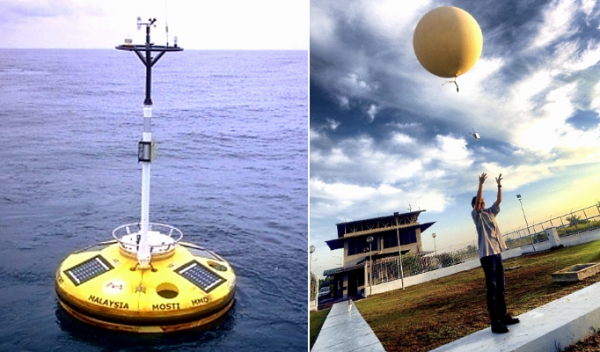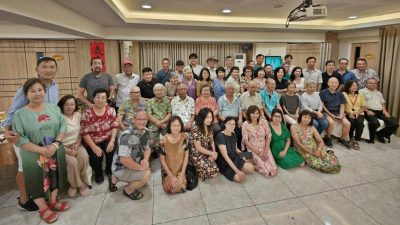Malaysian Meteorological Department (Met Malaysia) director-general Muhammad Helmi Abdullah

Before he graduated from the university, Muhammad Helmi Abdullah never thought he would become a meteorologists some day.
He was very much hooked on the computer, and thought he would do something related to system analysis or software development in future.
It was in the 1980s. He had just graduated with a degree in mathematics from Universiti Malaya. Computer was still not very common in those years, and jobs in this line were scarce and hard to come by.
Right then, the meteorological department was hiring, and he thought he should give it a try.
33 years of service at Met
So he joined the meteorological department and had been working there until he was promoted the department’s director-general this August.
Muhammad Helmi has been involved in many different departments and units throughout his 33 years of service at the Met.
He was first stationed at the office in Sabah, and was later sent to Melbourne for a year’s training. Upon returning to Malaysia, he was sent to Selangor, responsible for weather forecast at Subang airport. He was later sent to several other units.
Before he was promoted DG, Muhammad Helmi was the deputy DG in charge of the department’s operation.
There are many different units within the Met, some operating round the clock such as aviation meteorological services. Others are support units such as IT support which ensures smooth operation of the Met’s computer system handling massive amounts of weather-related data.
There are many technologies as well as equipment involved in the Met’s operation, including weather radar used to detect the distribution and intensity of precipitation in the atmosphere, the Stevenson screen used to shield the instruments against the elements, as well as weather balloon which is launched twice a day.
The importance of data sharing
Malaysia is one of the members of the World Meteorological Organization (WMO) and therefore has the responsibility and obligation to share weather data with other member states.
Muhammad Helmi said, “For example a typhoon that is about to hit the Philippines could also affect Malaysia even though it happens outside of the country’s territorial waters. This is because it may bring powerful gusts to some places in Sabah and Sarawak.
“That’s why data sharing is so important among WMO members.”
Many people think the meteorological department is only responsible for forecasting temperature, probability of precipitation and wind speed, but it has a whole lot more stuff to do.
The Met needs to closely monitor more unusual climatic phenomena since the South Asian tsunami in 2004.
Prior to the tsunami, there were already earthquake observation stations in this country although most of them were manually controlled and the data were not up to the minute.
There was this urgent need to enhance the Met’s geophysics and tsunami detection abilities after the tsunami. Today, earthquake observation centers, tide gauges and tsunami warning systems are found at strategic locations across the country.
Although the country is extremely unlikely to be struck by an earthquake or tsunami compared to neighboring countries like Indonesia and the Philippines, Met Malaysia cannot afford to take things too lightly.
Muhammad Helmi said, “Although some believe animal behaviors can be used to predict an earthquake, scientific researches show that an earthquake cannot be precisely predicted, and can only be detected once it happens.
“And this brings us back to the question why meteorological data sharing with other countries is of paramount importance.
“For instance, from the data collected in the Philippines, we should be able to evaluate whether an earthquake or tsunami hitting the Philippines will affect us and whether a tsunami warning should be issued.”
Two years after Muhammad Helmi took part in an oceanographic study tour in 2001, Malaysia installed its first oceanographic buoy in South China Sea near Layang Layang.

Uptrend in extreme weather phenomena
Before he was appointed the Met’s DG, Muhammad Helmi had represented the country at the Intergovernmental Panel on Climate Change (IPCC) meeting.
IPCC studies show that there is an increasing trend in extreme weather phenomena across the world while the Met’s observation records show a gradual rise in ambient temperature in this country.
Besides closely monitoring the country’s daily weather patterns, the Met is also using a supercomputer acquired in 2017 to predict climatic changes in the country over the next few decades.
Observation results will be of great benefits to a number of sectors. For instance, if the government plans to build a dam, it will have to identify the location with higher precipitation before deciding on the site. Farmers also need to know what impact climate change will have on them. Even the medical fraternity needs to be wary of changes to the weather patterns, as the breeding of insects such as Aedes mosquitoes would be affected by the weather.
Muhammad Helmi said the supercomputer used by the Met was the most powerful in the region when it was first deployed in 2017. Even then it might not predict the weather at 100% accuracy and the Met would still need to refer to the data computed by other countries before making comparisons and judgments.
Muhammad Helmi said anyone interested in a meteorological profession could consider pursuing a relevant course overseas, as such a course is not currently offered at local universities.
Having said that, he admitted that one doesn’t actually need a degree in meteorology to work at the Met so long as he or she has a degree in related fields such as mathematics, marine studies, physics or geophysics.
Training will be provided by the Met. During the early years, people were sent overseas for training but since the mid-1990s, training has been provided locally.
A growingly demanding job
Other than a relevant qualification, a weatherman also needs to have the following abilities:
1. Mathematical and analytical abilities in order to interpret large amounts of weather data.
2. Good communication skills to deal with people in different fields and levels, such as pilots (if stationed at the airport) where professionalism and technicality are prerequisites.
3. Ability to write reports which is particularly important during a change of work shifts.
4. Good physical and psychological qualities to deal with shift work and the ability to work independently.
While Malaysia is relatively free from natural disasters, the 2004 South Asian tsunami and the 2015 Ranau quake in Sabah have served as stern warnings that no country is absolutely safe.
Muhammad Helmi said we still have plenty to learn from other regional countries, especially in the detection of earthquakes and tsunamis.
More importantly, he said we have to remain always humble in the face of Nature, and no one should ever underestimate the power of Nature.

ADVERTISEMENT
ADVERTISEMENT


































